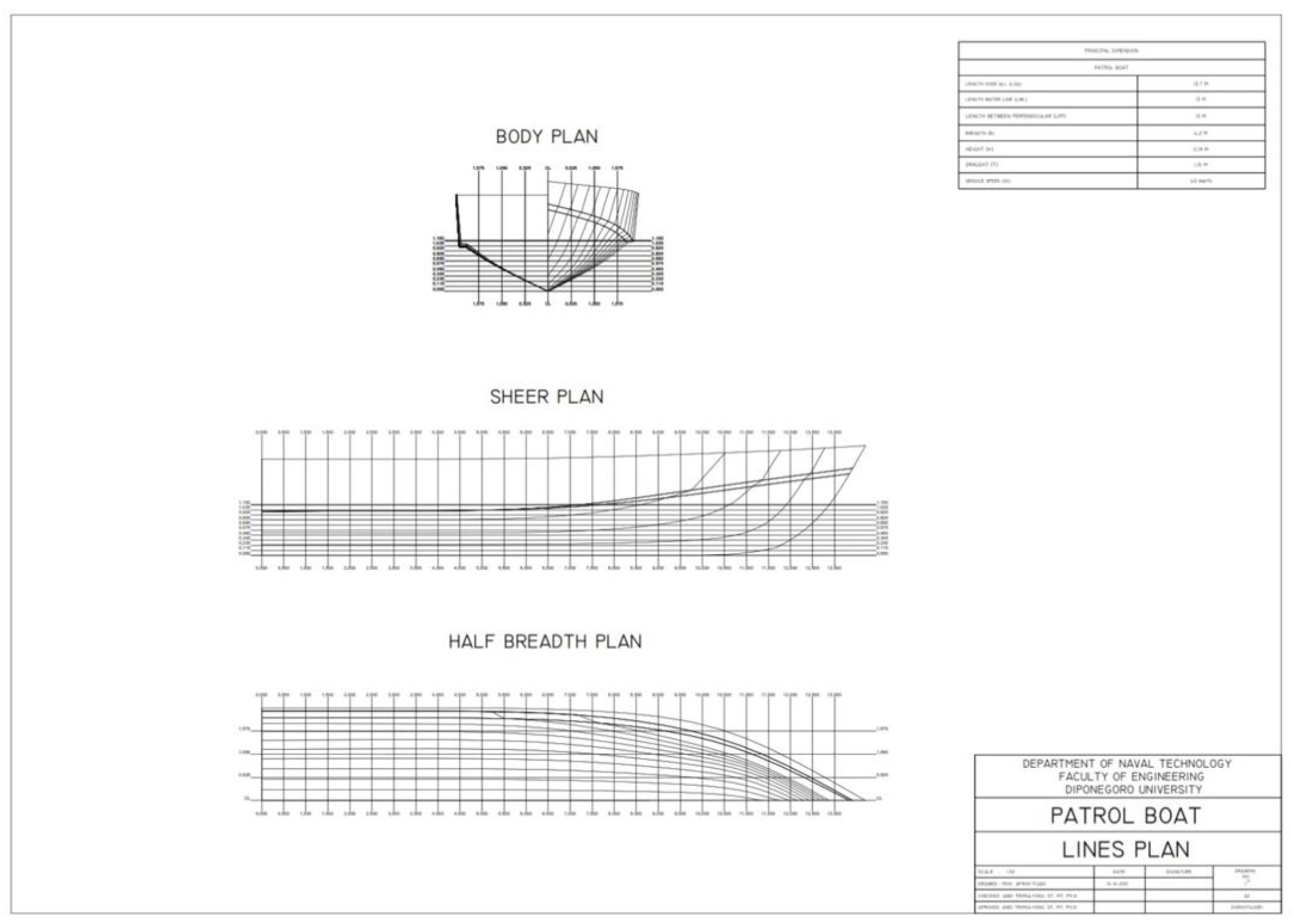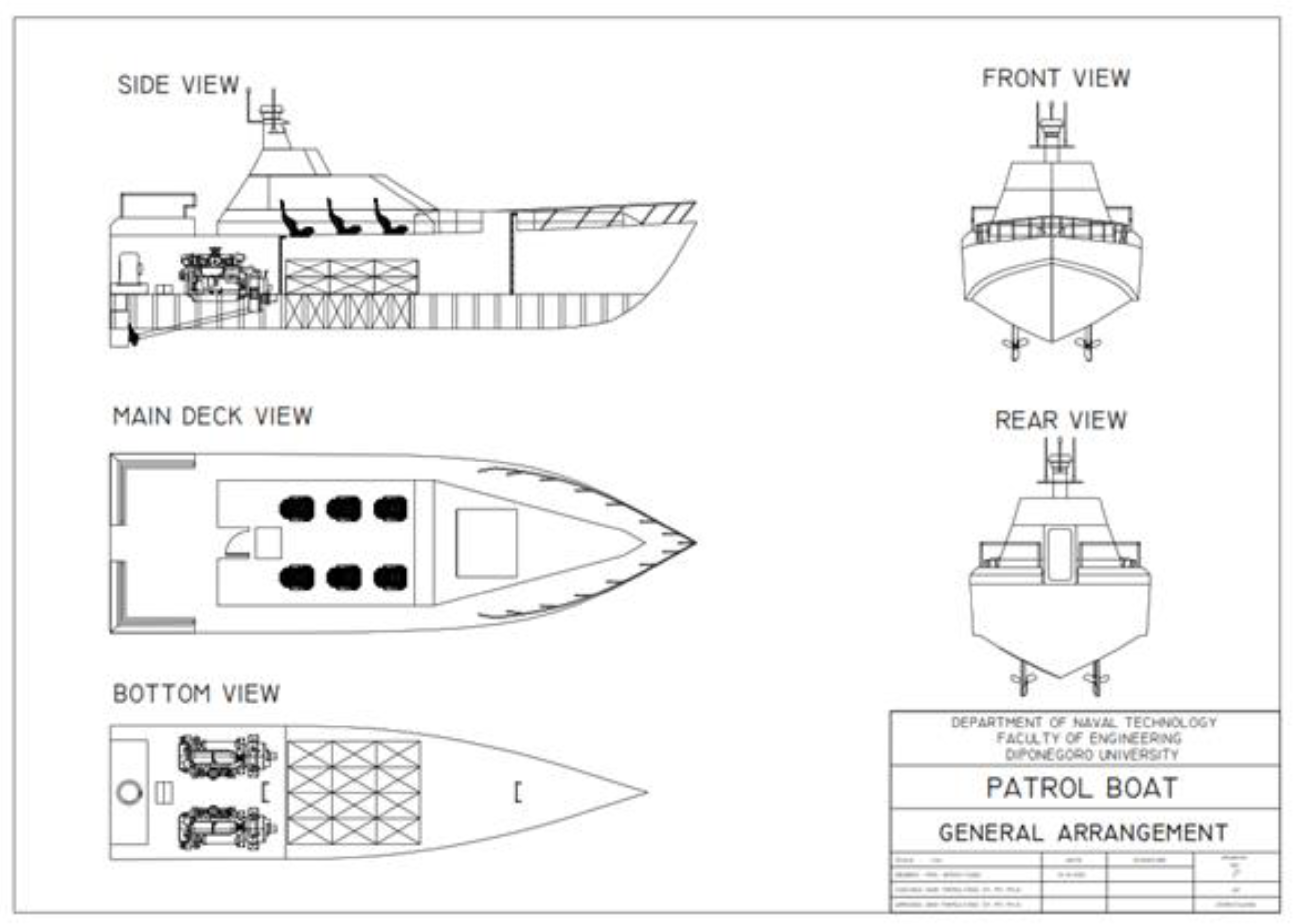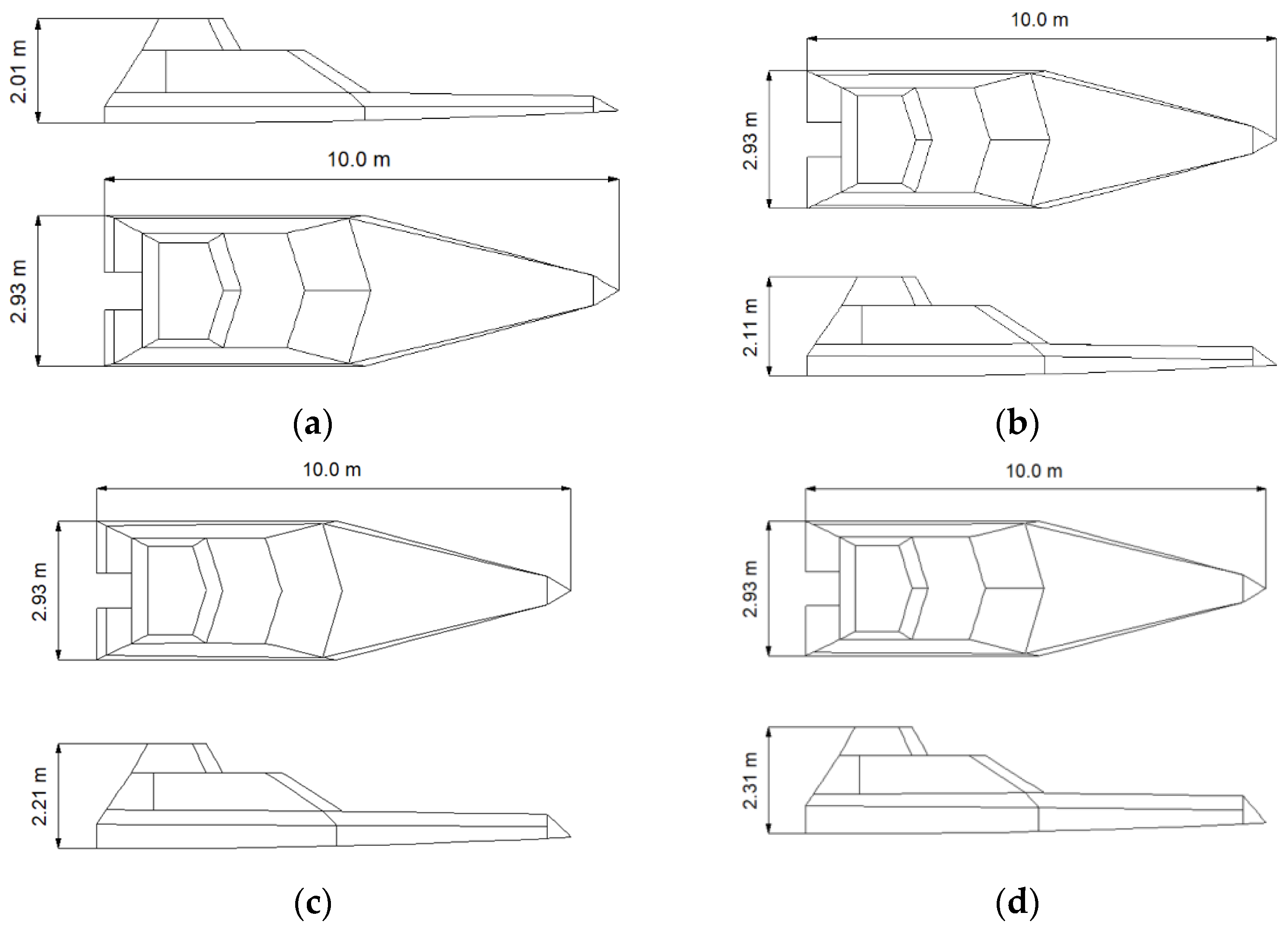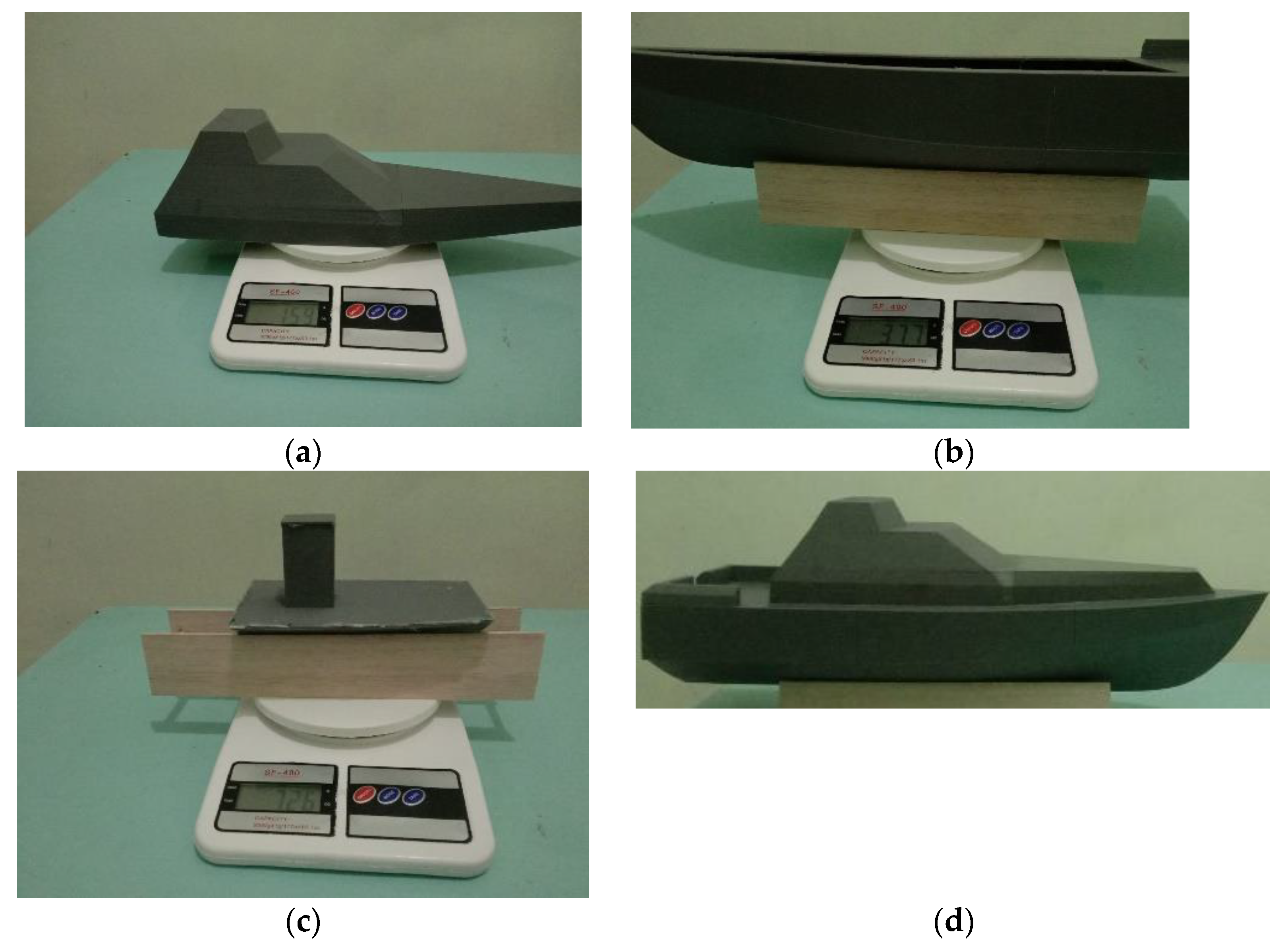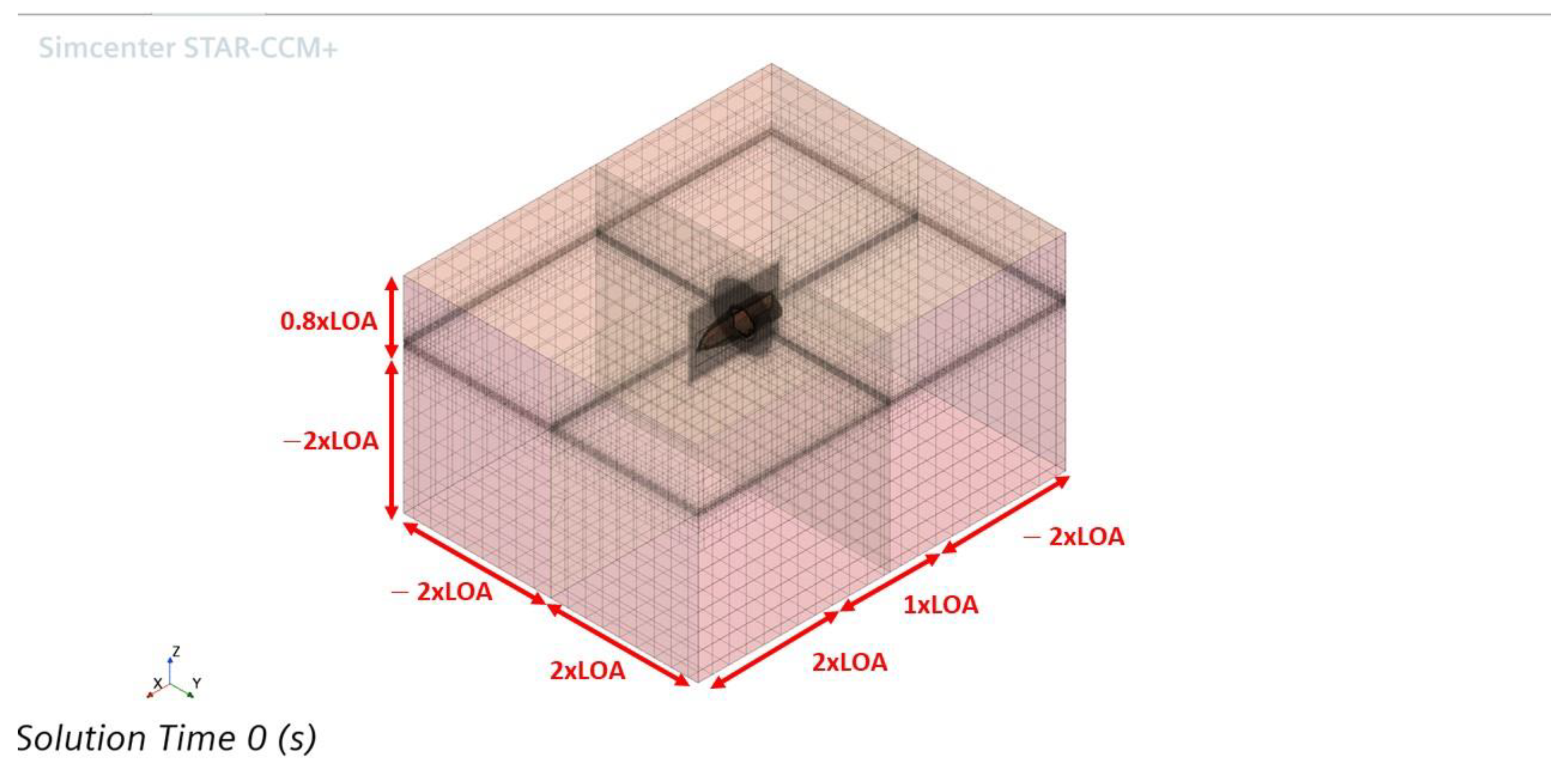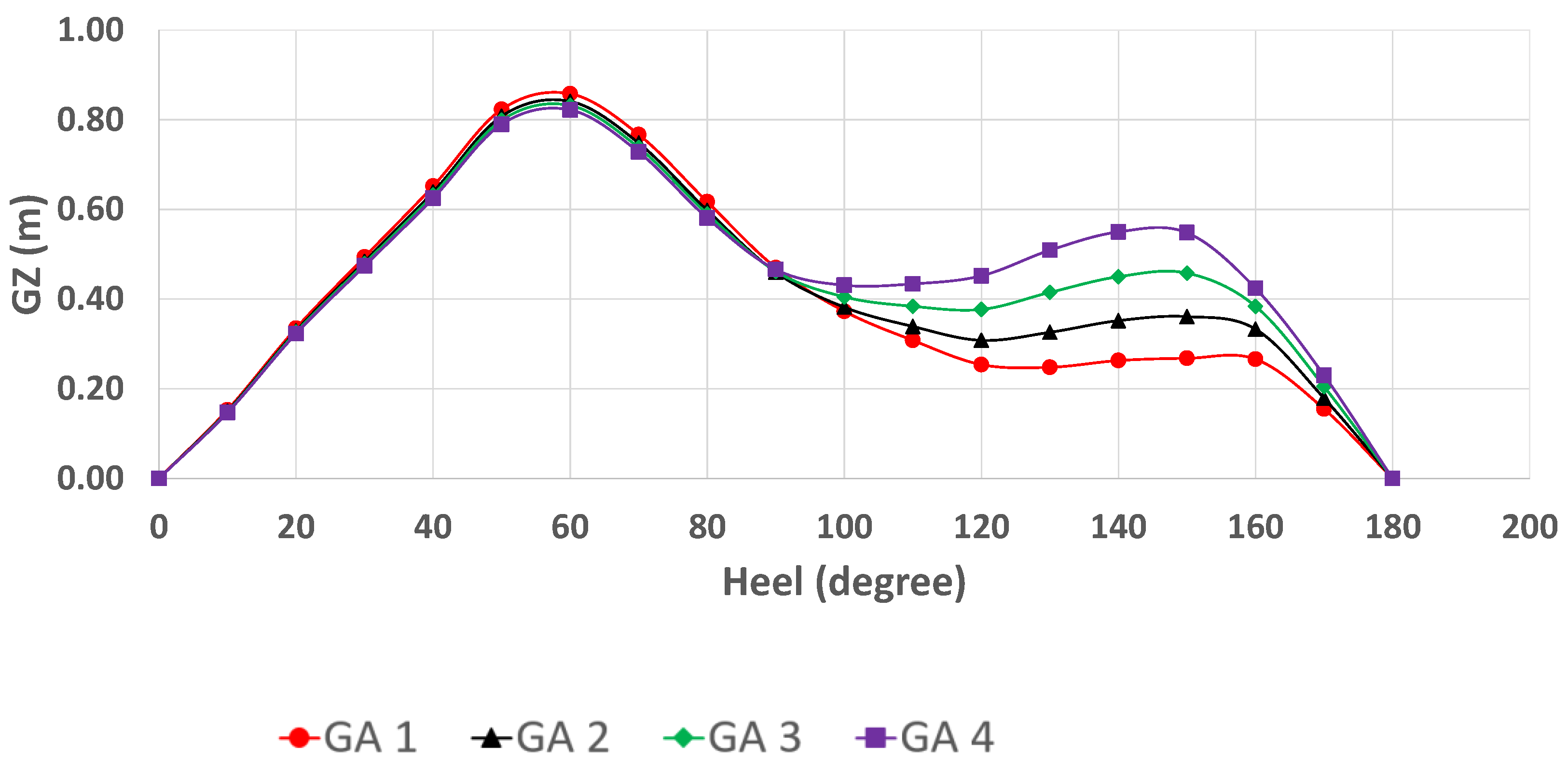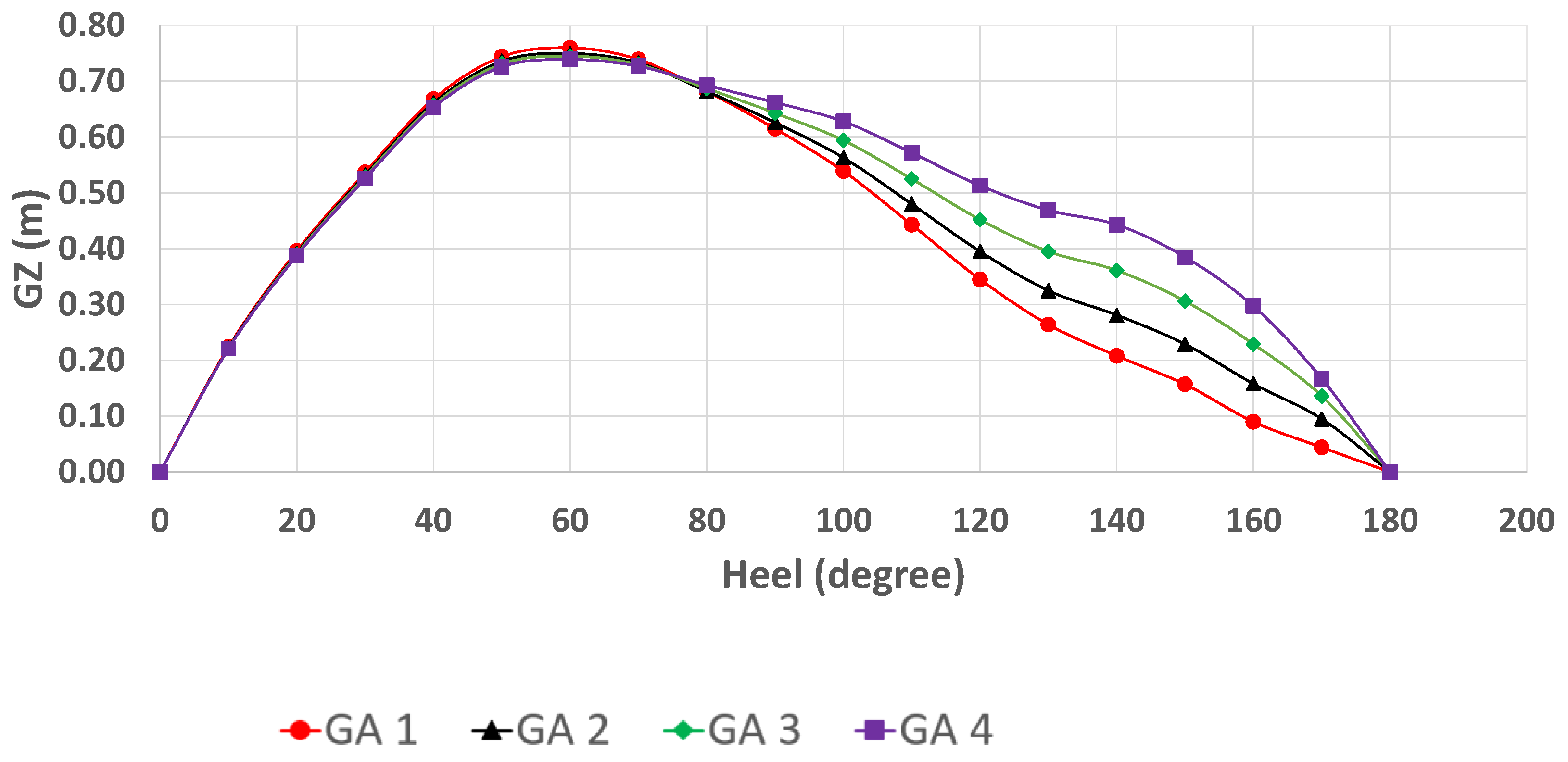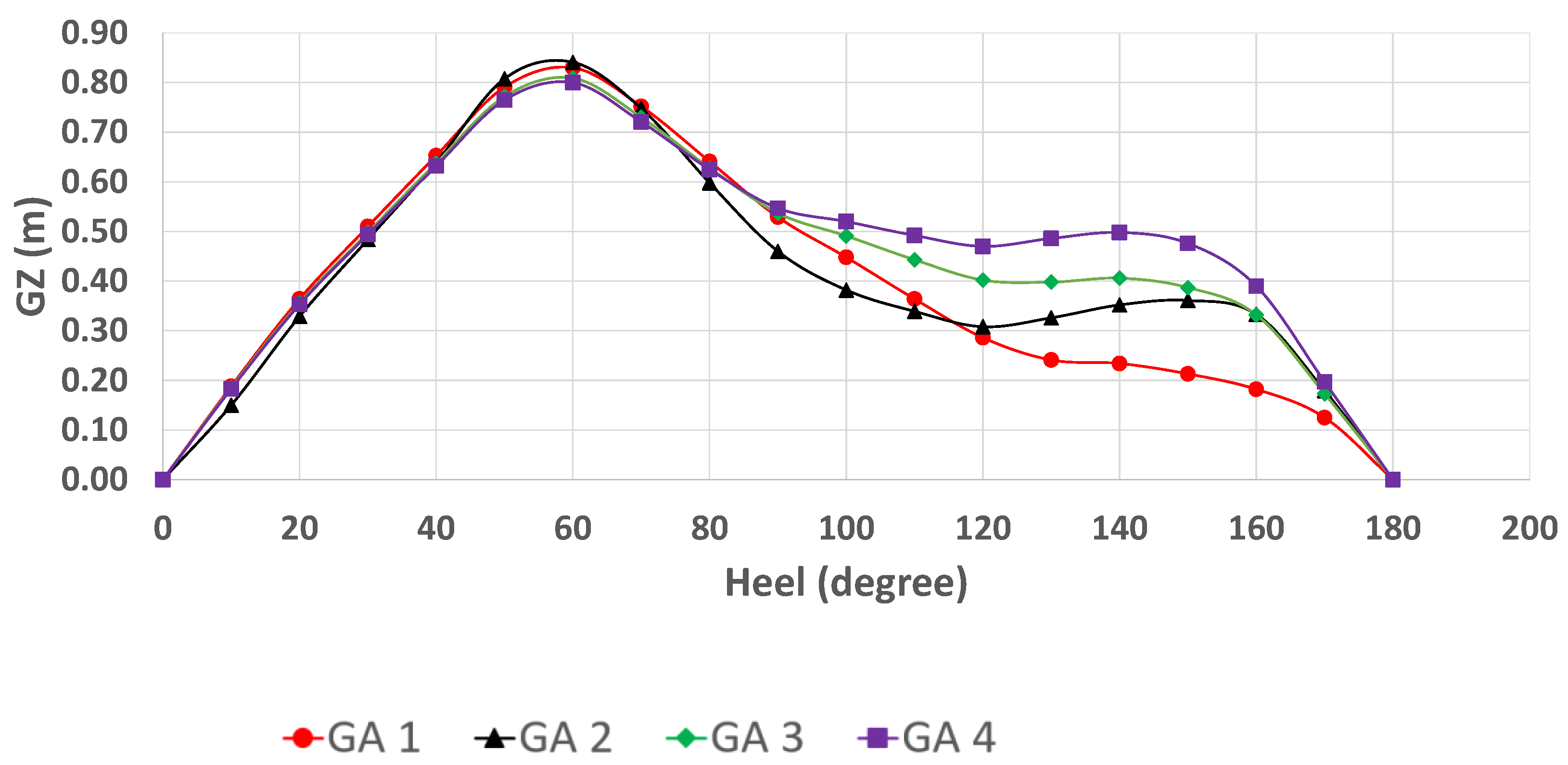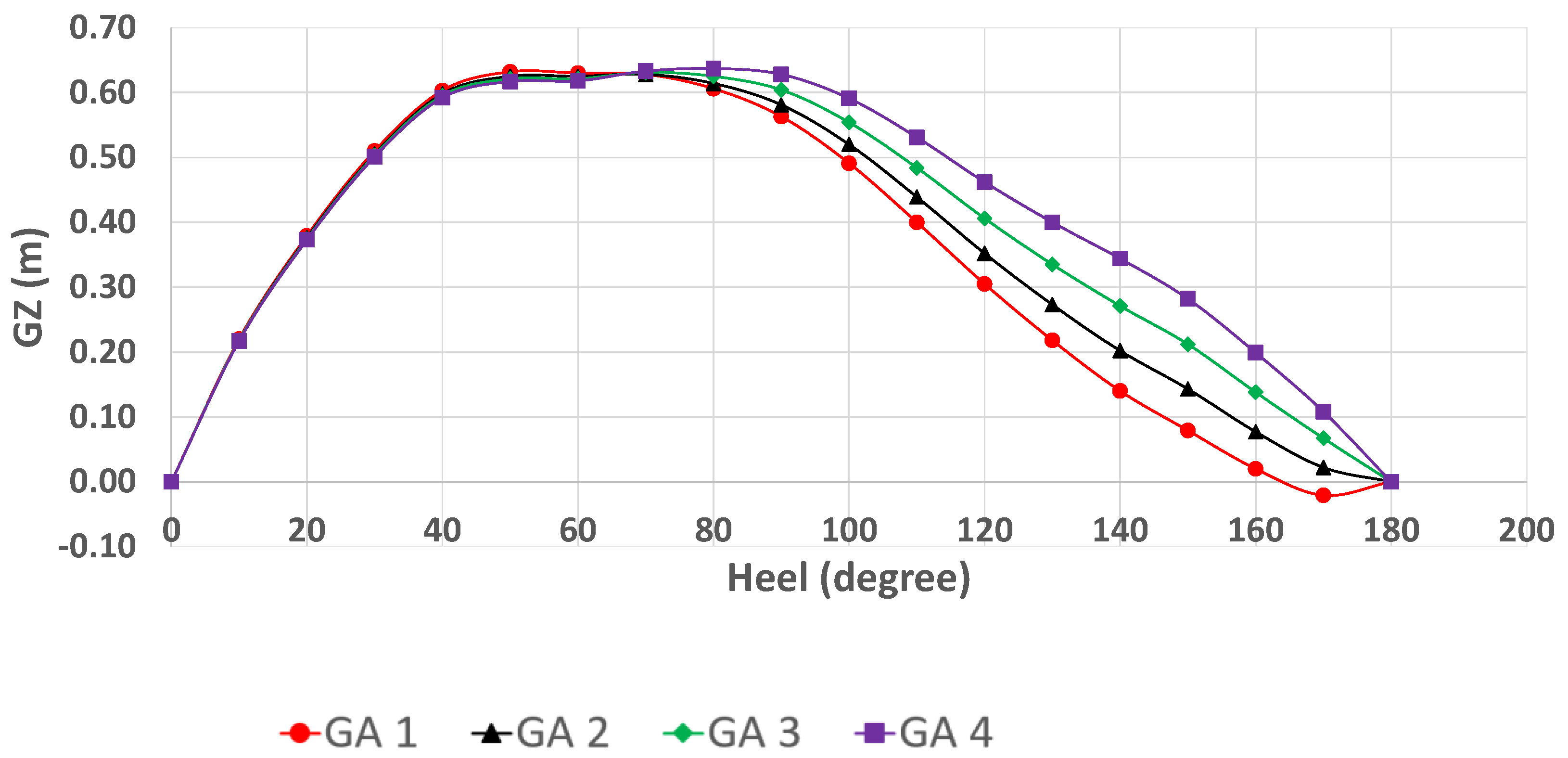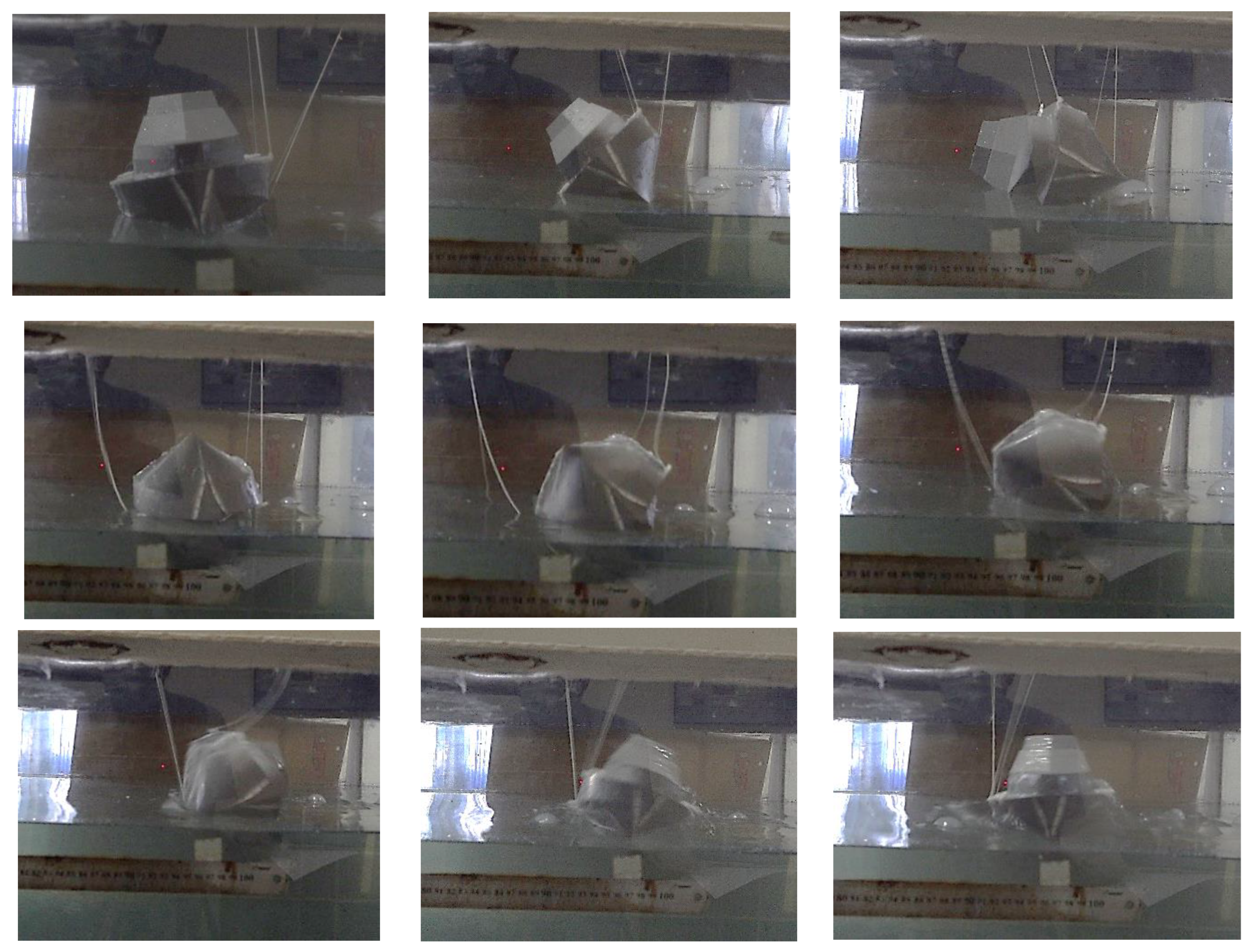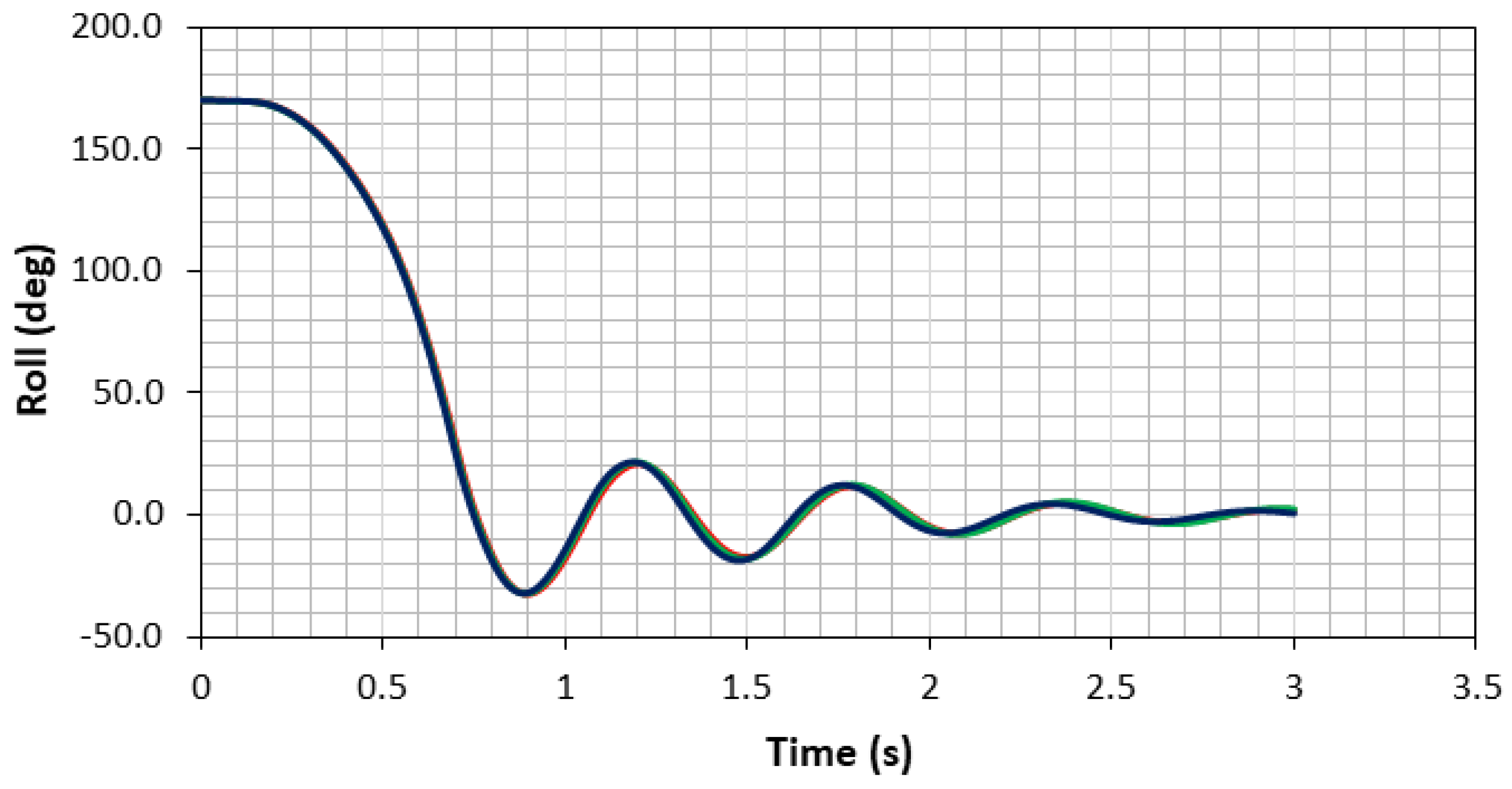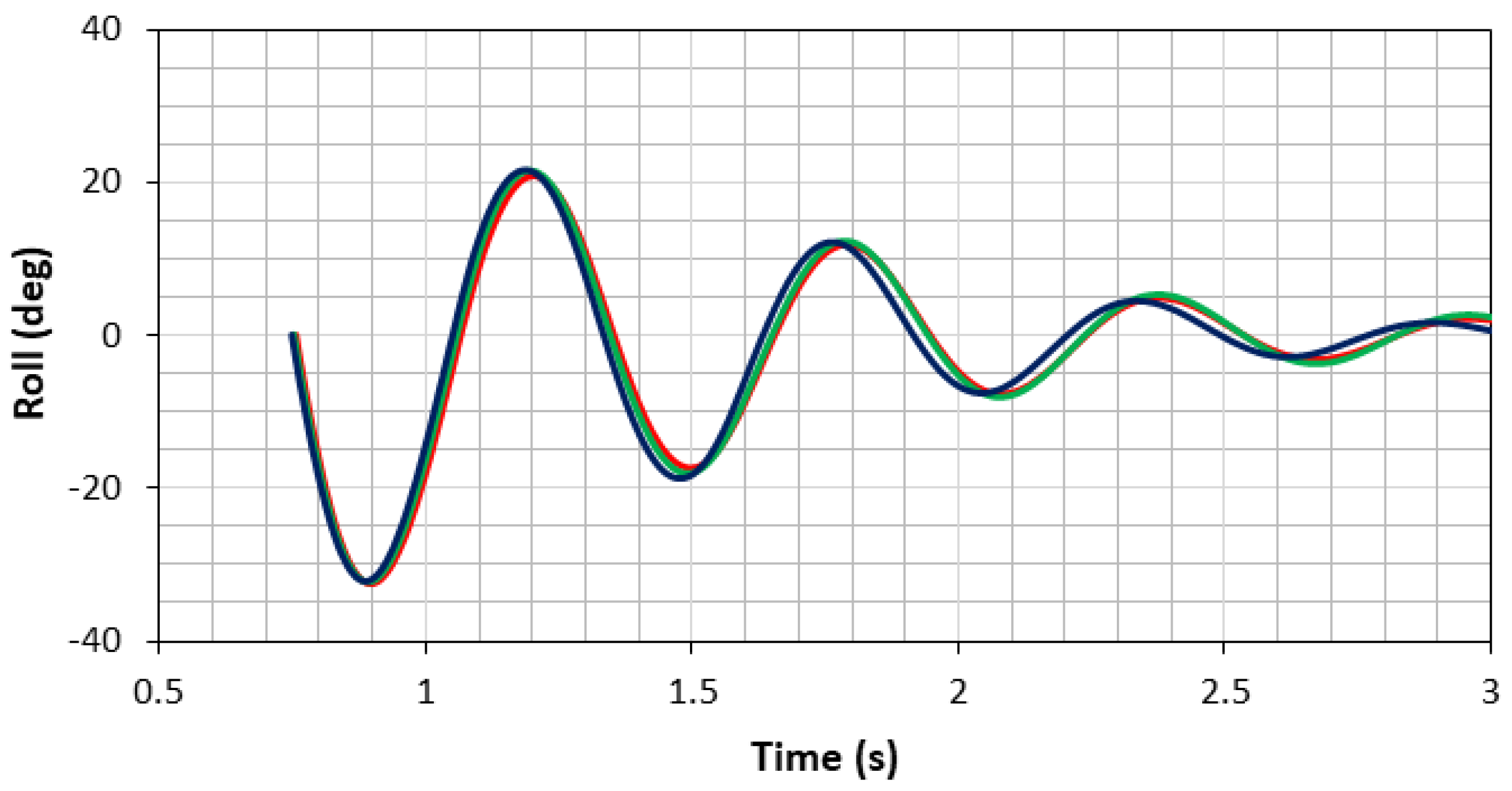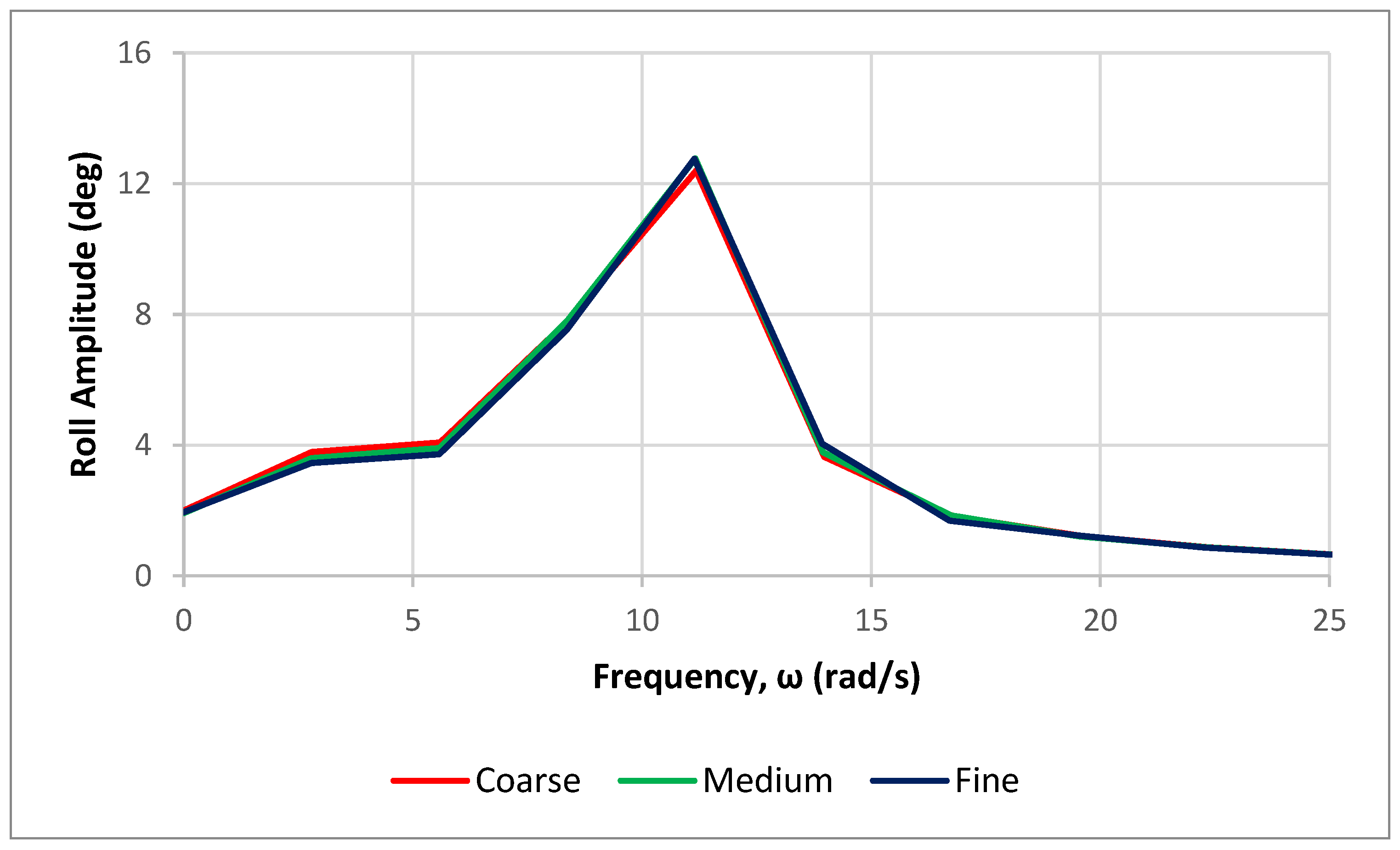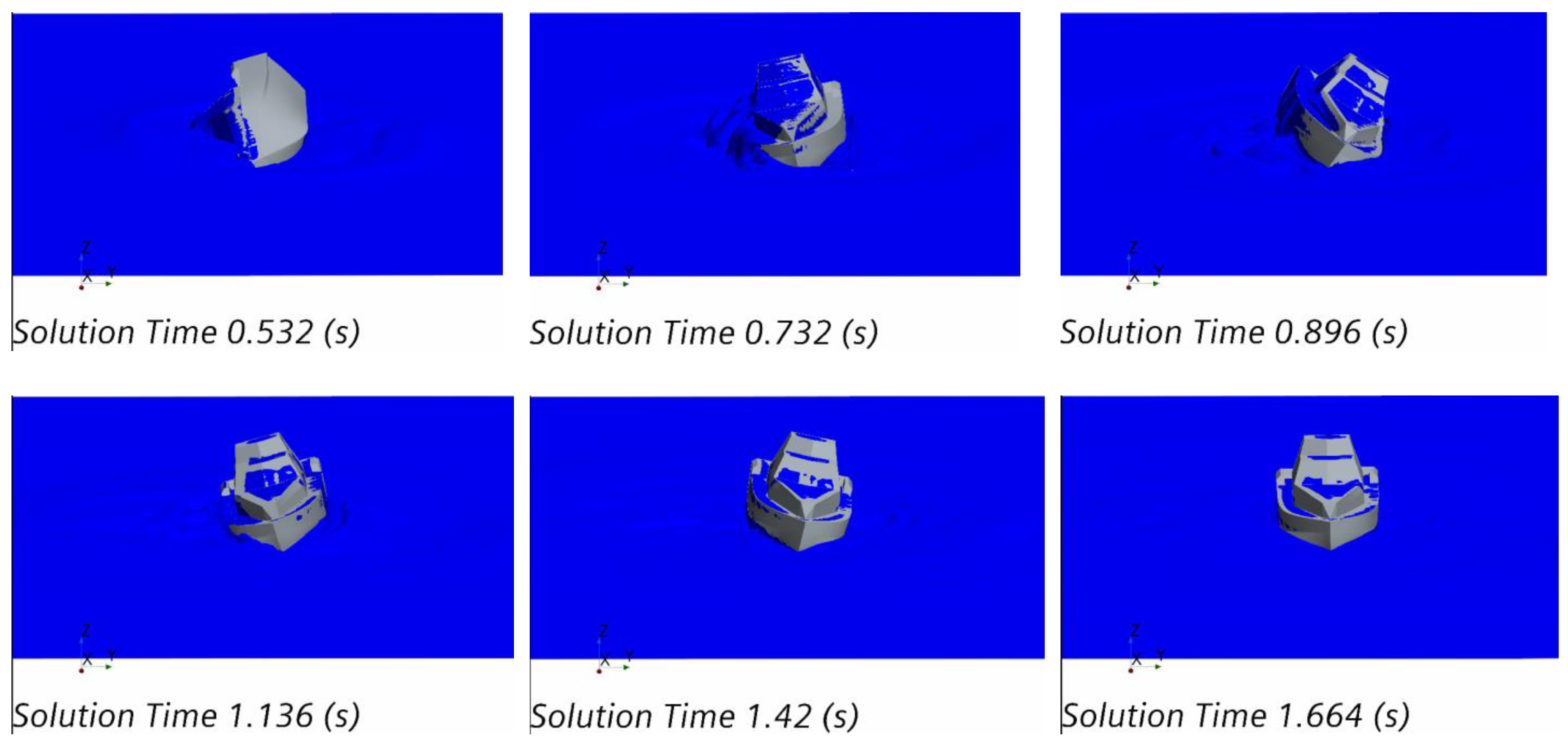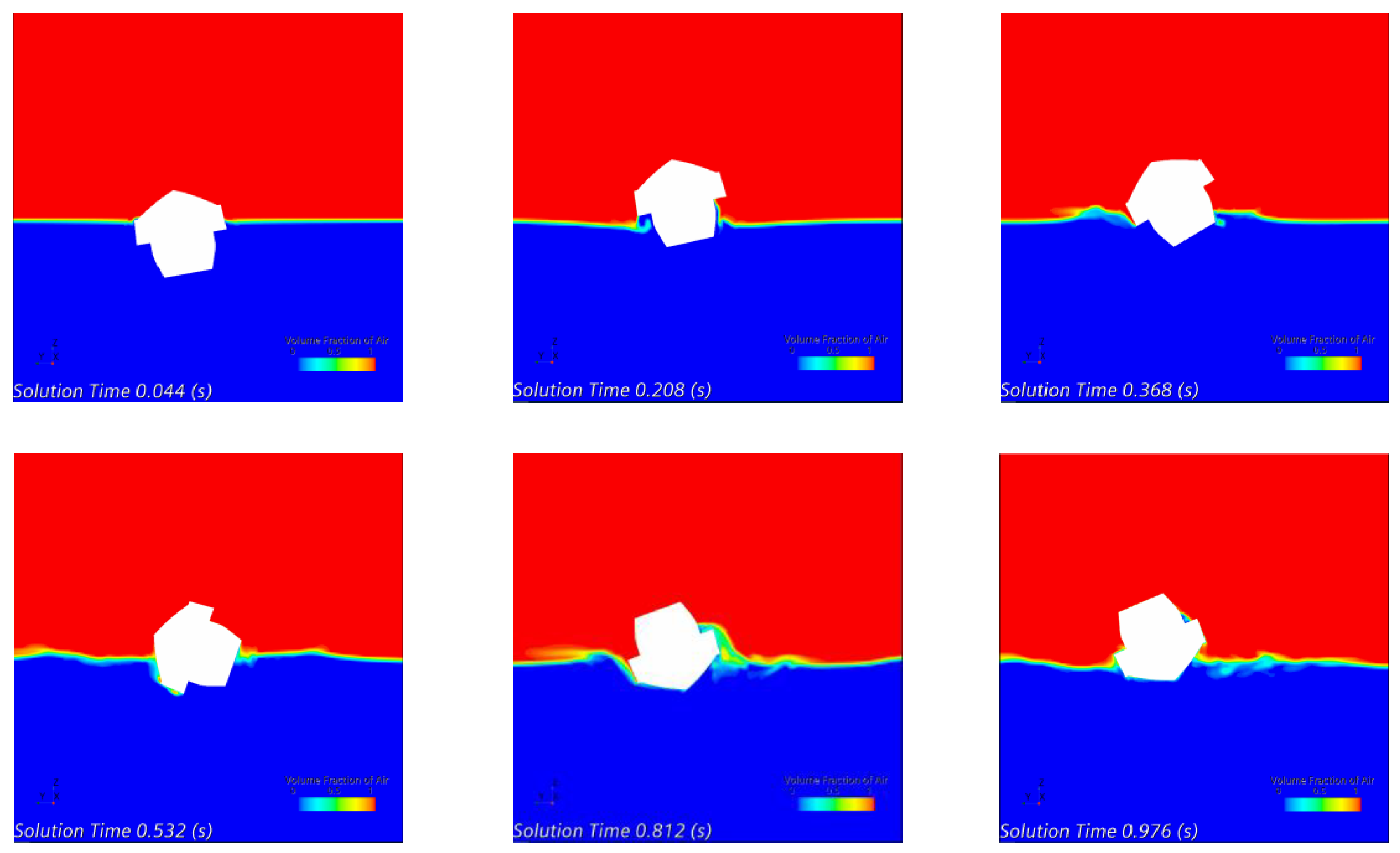1. Introduction
The patrol boat is essential for archipelago countries such as Indonesia to supervise and maintain the sea border. Many violations have occurred in the past, such as illegal fishing in the Natuna sea and border violations with neighboring countries. This indicates that the patrol vessel is an essential tool in Indonesia as a maritime and archipelago country. Patrol vessels operate in the Exclusive Economic Zone (EEZ) area, and, sometimes, sea conditions will be rough.
In harsh conditions, patrol vessels will experience strong winds and waves that affect the ship’s stability. The ship will also experience an extreme roll motion that can be over 90°. In this situation, the vessel can be capsized due to the loss of a self-righting roll moment.
A study of patrol vessels with interceptors was carried out with the CFD method and showed that the resistance could be decreased by adding an interceptor [
1]. A study of the aerodynamic load on patrol vessels using computational fluid dynamics (CFD) was conducted with an OpenFOAM solver [
2]. The study shows that CFD can provide reliable aerodynamic load predictions for high-speed vessels. An analysis of the survivability of ocean patrol vessels related to survivability, redundancy and technical endurance was performed using Monte Carlo analysis [
3].
The effects of side keels on patrol vessel safety in astern waves were studied by Maimum et al. [
4]. A study of the hybrid propulsion system Diesel Mechanical and Diesel Electric Propulsion (DMP and DEP) for a trimaran fast patrol boat was carried out by Windyandari and Wahyudi [
5]. Moreover, a flat-hull ship was used as a patrol vessel in concept design [
6]. A ship with a self-righting moment was studied for SAR purposes and patrol [
7,
8]. The study indicates that the capacity for a self-righting moment still exists in rolling above 180°. Rolling is one of the most dangerous motions on a ship; if the ship loses the self-righting moment during rolling, as a result, the ship will capsize.
Many studies have been performed for ship rolling in extreme conditions, and numerical methods such as computational fluid dynamics (CFD) are often used in ship stability. CFD prediction of full-scale ship parametric rolling in heading waves was performed by Liu et al. [
9]. The study showed that CFD has the capability to reproduce ships in the wave.
The application of CFD to predict the roll response of damaged ships during quasi-steady flooding in beam waves was conducted by Xu et al. [
10]. Full-scale self-propulsion computations using a discretized propeller for the KRISO container ship KCS was carried out by Castro et al. [
11]. The results showed that CFD had good agreement with the experiment.
CFD validation and grid sensitivity studies of full-scale ship self-propulsion were carried out by Jasak et al. [
12]. Overset grids in OpenFOAM with application to KCS self-propulsion and maneuvering were described by Shen et al. [
13]. The study showed that the naoeFOAM-SJTU solver could reproduce the self-propelled phenomenon. Verification and validation of the flow around the KVLCC2 tanker at a model and full scale was performed by Pereira et al. [
14], and a numerical investigation of the 6-DOF seakeeping performance of the KCS containership was performed by Lungu [
15].
Prediction of the pitch and heave motions in regular waves for the DTMB 5415 ship using CFD was compared with the use of MMG [
16], and the study showed CFD results similar to those of the MMG model. It can be concluded that CFD has good accuracy for ship hydrodynamics prediction. In this paper, a self-righting moment in rolling above 180° was considered both in the physical model and CFD.
The present work was conducted to study the effect of the self-righting moment in a high-roll-angle condition. In this condition, the ship undergoes dynamic conditions because of the change in the center of gravity and buoyancy. The ship could lose the self-righting moment if there is a negative roll moment in the upright ship in the original condition.
The patrol vessel has a small breadth, making the self-righting roll moment smaller and linear with a breadth ratio. Moreover, patrol vessels operate in nearshore regions that sometimes experience rough conditions, which could lead to extreme roll motion. In this study, the patrol vessel was designed with a self-righting moment in rolling up to 180°. The design of the ship had four different heights of the deckhouse, with increments of 10 cm to increase the roll moment in the heeling condition.
One of the aims of this study was to select the ship design that has the highest righting roll moment; thus, the ship can return to the upright position after heeling with the high angle. Another aim was to prove the existence of the self-righting roll moment on the boat by conducting an experimental test of the 1:27.4 physical model scale. Moreover, the numerical approach of computational fluid dynamics (CFD) was used to support the physical model results.
2. Methods
The physical model of the ship design was first created by modeling a ship with a basic design.
Figure 1 shows the body plan of a ship for patrol dan search and rescue (SAR). The body plan indicates a view of the ship in the longitudinal (side and bottom view) and transverse view (front view). The ship was designed with a single chine to increase the ship speed, which it used as a lift force due to the spray effect of water passing the hull, which bends around the side of the ship. In this study, the ship was designed for fast patrol. This is another reason that chine was used in the ship.
Table 1 indicates the principal dimensions of the ship, where LBP is the length between perpendiculars, B is the ship breadth, H is the ship height, and T is the ship draft. The ship dimensions were based on a Barracuda vessel (
https://www.safehavenmarine.com/barracuda (accessed on 18 January 2022)) with a self-righting capability. The ship was designed for six passengers with six pieces of baggage and cargo. Detailed information of the ship’s general arrangement can be seen in
Figure 2.
The height of deckhouse variation was achieved with increments of 10 cm to increase the height of the ship’s metacenter.
Figure 3 illustrates four deckhouses with a height increment of 10 cm. The deckhouse was assumed to be watertight. This assumption was made to ensure that when the boat was heeling, water could not enter the boat and cause the ship to capsize due to flooding.
Table 2 describes the load case condition of the boat, used to calculate the heeling arm for several conditions—for instance, lightweight, zero cargo, half of the cargo and the full load condition.
Table 3 shows the dimensions of the physical model of a ship. This model was tested in a mini towing tank in the Department of Naval Architecture, Universitas Diponegoro.
Due to the limitation of the width of the tank, a scale of 1:27.4 was chosen in this study.
Figure 4 shows a physical model of a ship with a solid ballast. Solid ballast 1262 gr was used to obtain a similar full-scale ship.
Table 4 shows the calculation of the center of gravity of the ship model. The calculation of the center of gravity is shown in
Table 5. It has a difference of 6.15% for longitudinal center gravity and 9.20 for the keel to gravity.
Figure 5 illustrates the computational domain for CFD setup; the self-righting moment was simulated with roll decay analysis to prove that the boat could return to an upright condition after rolling at a high angle. In this study, roll decay simulation was conducted using commercial CFD software, Siemens Star-CCM+ version 16.04.
Figure 5 shows the fluid domain size for this simulation, which is -Lpp × 2Lpp, -Lpp < y < Lpp and -Lpp < z < 0.4 Lpp. The size of the box for free surface refinement on the background region is -2Lpp × 2Lpp, -Lpp < y < Lpp, and -(1.2Hw × 0.5) < z < (1.2Hw × 0.5). For the overset region, the height of the box for free surface refinement is −0.5 m < z, 1.00 m. This size covers the ship height.
The finite volume method (FVM) was used to discretize the integral form of the Unsteady Reynolds-Averaged Navier–Stokes (URANS) equations. A second-order convection scheme was used for the convective terms. For the time-domain solution, a first-order temporal discretization was used. The continuity and momentum were linked using a predictor–corrector scheme. The flow equations were solved in an uncoupled manner. The overall solution procedure was solved using the Semi-Implicit Method for Pressure Linked Equations (SIMPLE) algorithm.
The turbulence effect in the boundary layer region was modeled using the Shear-Stress Transport (SST) [
17], which blends a k-ɛ model in the far field with a k-ω model near the wall. The all-y+ treatment scheme was used to treat the boundary layer region either for fine grids (when y+ < 5) or for coarse grids (when y+ > 30). To capture the free surface, the Volume of Fluid (VoF) method, introduced by Hirt and Nichols [
18], was used. VoF defines two phases of the fluid (water and air) by assigning a scalar value of 0 to air and 1 to water in each cell. Then, value of the interface between two fluid phases (the cells contain water and air) is 0.5. The flat wave modules with zero velocity were used to represent fluid in the computational domain without waves when the boat was at zero velocity.
The dynamic fluid body interaction (DFBI) module was used to capture the two degrees of freedom of the boat in the roll decay simulation, which are roll and heave. This module computes the exciting forces, moment and gravitational force acting on the hull surface and solves the governing equation to determine the new position in each time step.
Figure 6 shows the two regions, overset and background, that are used in this paper. Overlap refinement was employed between two regions to ensure that the roll decay simulation was smooth. Another refinement was located near to the free surface, called free surface refinement, to distinguish the water and air phases with high precision.
For the generation of the mesh, the automatic mesh tool in Star CCM+ was employed, called a trimmed cell mesh, and a surface remesher. This tool uses the mesh Cartesian cut cell method. The total thickness of the prism layer around the hull surface is 1.095 × 10−3 m, which is divided into six layers of prismatic cells with the stretching factor of 1.2 and results in the first layer of 1.104 × 10−4 m.
The total cells of the generated mesh amount to 4,213,084 cells. For Grid Convergence Index (GCI) analysis, the generated mesh, later referred to as the fine mesh configuration, was coarsened with the refinement ratio √2, and then it was denoted the medium mesh configuration. The total cells of this configuration amounted to 1,592,881 cells. This configuration was then coarsened again with the same ratio to achieve a coarse mesh configuration and resulted in a total number of cells of 709,885.
The choice of time step in this study was based on the ITTC recommendation. It is recommended for periodic phenomena, such as roll decay, and the time step should be at least 100 per period. In this case, the natural roll period is approximately 0.56 s. The minimum time step based on the ITTC recommendation is 0.0056. However, in this study, CFD simulation used a time step of 0.004 s, which was lower than the ITTC recommendation.
Fourier series (FS) analysis was used to quantify the results of roll decay simulation, which considered the unsteady time series of roll amplitude. This analysis converted the time-domain results into frequency-domain results. It was undertaken for the three mesh configurations, which were fine, medium and coarse. Next, the roll response in the frequency domain for different mesh configurations was compared. Each unsteady history φ(t) could be represented by a Fourier series in time, as shown in Equation (1).
where
is the nth harmonic amplitude and γ
n is the corresponding phase, which can be determined by the following equations.
where
The 0th harmonic amplitude
is the average value of the time history of
φ(
t). Grid Convergence Index (GCI) analysis was used as a verification method. The formulae to calculate this index are shown in Equations (7)–(11). The verification study was carried out to quantify the numerical uncertainties of the CFD model. This index is based on Richardson extrapolation [
19] and the method adopted according to Celik et al. [
20].
,
and
are the frequency-domain roll responses obtained from the fine, medium and coarse configurations.
is the convergence ratio, which is monotonic for 0 <
< 1, oscillatory convergence for −1 <
< 0 and a divergent solution for
< 1 or
> 1.
is the order of accuracy.
is the refinement ratio.
